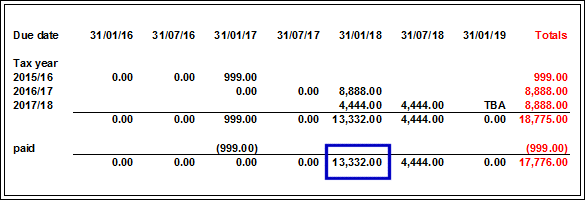It’s normal for some people to make tax payments on account every 6 months
If you’re self employed, or have lots of income from rent, dividends or investments, you may have become used to the pattern of making tax payments every 6 months.
However, the way the rules are structured, it normally comes as a bit of a surprise the first time you encounter the the “payments on account” regime. PoA for short. If most of your tax is paid under PAYE you won’t need to worry about this. The rule is twofold:
- If your PAYE tax deduction (and any sundry tax deduction) is more than 80% of your total tax bill, then PoA do not apply.
- If your total tax payment for the year comes to less than £1,000 then PoA do not apply.
In all other cases, individuals (but not companies) will have to pay an instalment of tax every 6 months, on 31 January and on 31 July. And that normally applies to people who are self employed or have lots of income from rent, dividends or investments. The best way to explain this is to give you an illustration, based around the chart below. Let’s say that. . .
- your taxable income first arose in the tax year 2015/16
- your 50% payments on account are based on the previous year’s tax bill
- as the previous year’s tax bill (2014/15) was NIL, you made no PoA on 31 Jan 16 and 31 Jul 16
- when your tax return was finalised, your 2015/16 tax bill came to £999 and you paid that on the normal due date of 31 Jan 2017
- that amount was below the £1,000 limit and so your PoA for 31 Jan 17 and 31 Jul 17 were also set at NIL
- and then you go and have a really good year in 2016/17

- so good, that your 2016/17 tax bill comes to £8,888
- now you’re caught
- not only do you have to pay the 8,888 on the normal due date of 31 Jan 2018, but the PoA kick in at the same time
- the first instalment of 4,444 for 2017/18 is due on the same day – 31 Jan 2018 – in this illustration that’s going to lead to a single payment of £13,332
- and another £4,444 is going to be due on 31 Jul 2018
- if the payments on account of £4,444 and£ 4,444 are not precisely right for 2017/18 then a TBA adjustment is made on 31 Jan 2019
- that could mean more tax to pay, or a tax repayment
- and the next 50% instalment will also be due on 31 Jan 2019, and so on
It sometimes looks like you have to pay 2 years worth of tax in the space of 6 months. It has often been said that “if you’re self employed you don’t pay tax for two years”. That’s sort of true, but then it all catches up with you and you end up paying two years worth of tax in the space of 6 months.
We know what you’re thinking and we’ve heard the message before. You can contact your MP here (use the search labelled “Find an MP by postcode”). We simply have to follow the rules!
The only way to keep things under control is to regularly put aside a tax reserve and to do your accounts and tax return soon after 5 April every year. Then there should be no nasty surprises.
A Reduction?
What happens when you have a really good year followed by a really bad year? Your payments on account in the new year are automatically based on your tax bill for the old year, because HMRC (and the legislation) assumes that your taxable income will continue on a steady trajectory, going up.
When it goes down, you may struggle to pay high instalments. And you don’t have to. There is a mechanism to apply for a reduction, and it’s called the SA303 process. Let us know if this is relevant to you.
Before the 31 January tax payment date we may be able to work with your figures for 9 months of the tax year (to 31 December) and make a reasonable judgement call on the picture for 12 months, and hence deduce what a reasonable instalment would look like. For relevant clients, we follow this routine in the first two weeks of January each year, and provide advice before the end of the month. It’s important though to ensure that we have 31 December figures just after December ends.
January is our busiest month of the year, in the run up to the 31 January tax payment date, and tax return submission deadline. We will do the best we can, and it’s a case of first come first served.
The knock on effect
If it turns out that the new instalments are too low, and that insufficient tax is going to be paid, then an additional tax bill, and late payment interest are inevitable. Therefore, when the January SA303 is prepared, a pragmatic approach is needed, and it would be unwise to “just ask for instalments of NIL”.
In any case, whether we over or under estimate, it’s usually a good idea to have the next tax return prepared soon after 6 April and before the second instalment is due on 31 July.
